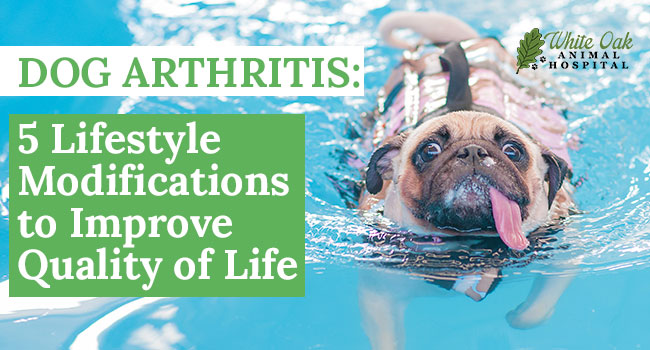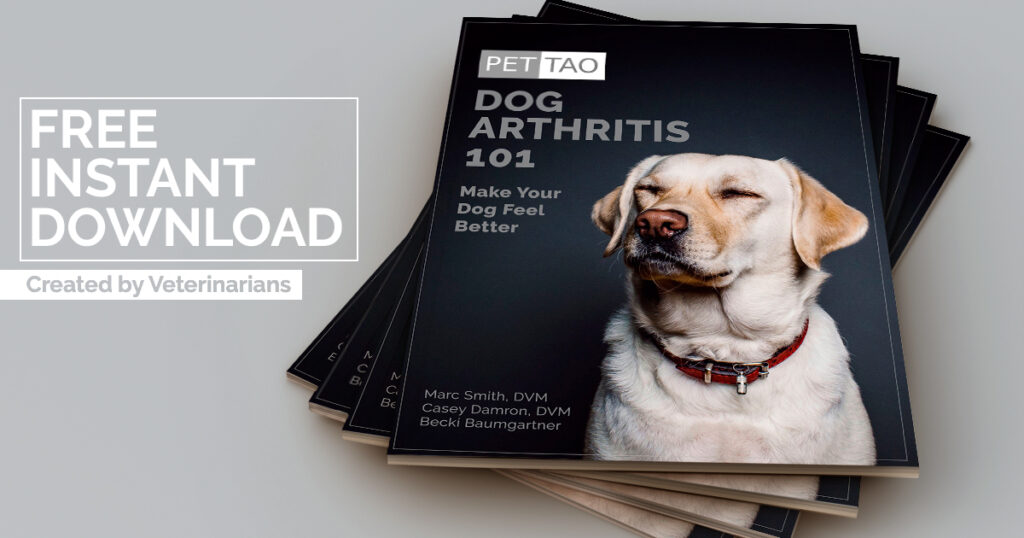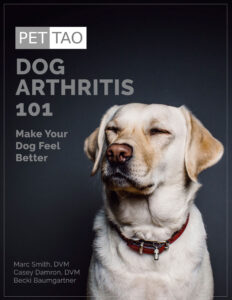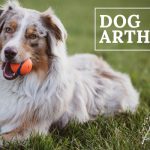
In the realm of canine health, arthritis is a significant concern, profoundly impacting the quality of life for our furry companions. This joint condition, prevalent among dogs, necessitates our attention and care to ensure their well-being. Understanding its implications is crucial for every pet owner. Dog arthritis, also known as osteoarthritis (OA), entails the deterioration and inflammation of joints, leading to discomfort and hindered mobility.
Arthritis can diminish a dog’s ability to perform everyday activities, affecting their overall happiness and vitality. Recognizing the signs of Dog arthritis and implementing appropriate management strategies are paramount in enhancing a dog’s well-being and restoring their quality of life. Pet owners can access our free dog arthritis ebook to delve deeper into this topic and discover effective management techniques.
Understanding Dog Arthritis
 Dog arthritis, scientifically known as osteoarthritis (OA), is a complex ailment characterized by inflammation and degeneration within one or more joints. Dogs afflicted with OA endure discomfort and swelling in various joints, hindering their daily activities. Diagnosis of OA entails a meticulous physical examination, including palpation to assess pain intensity, alongside supplementary diagnostic procedures such as radiographs or other imaging technologies.
Dog arthritis, scientifically known as osteoarthritis (OA), is a complex ailment characterized by inflammation and degeneration within one or more joints. Dogs afflicted with OA endure discomfort and swelling in various joints, hindering their daily activities. Diagnosis of OA entails a meticulous physical examination, including palpation to assess pain intensity, alongside supplementary diagnostic procedures such as radiographs or other imaging technologies.
The etiology of OA is multifaceted, lacking a singular cause. Contributing factors include body conformation, weight management, abnormal joint development (such as hip or elbow dysplasia), activity level, history of injuries or orthopedic surgeries, and nutritional status. It’s crucial to note that OA in dogs typically results from combining these factors rather than solely attributed to age.
Recognizing the signs of OA beyond mobility difficulties is imperative for pet owners. Common indications include stiffness while walking, lameness, aversion to stairs or jumping, sensitivity to touch, diminished stamina, and even unexpected aggression.
Veterinary Guidance: Diagnosis and Treatment
When addressing concerns about dog arthritis, seeking veterinary guidance is paramount for accurate diagnosis and effective treatment. Veterinarians possess the expertise and resources to conduct thorough evaluations, ensuring a precise understanding of your dog’s condition. Proper diagnosis enables the implementation of tailored treatment strategies to alleviate discomfort and improve your pet’s quality of life.
Treatment options for dog arthritis encompass a variety of approaches, including medication, therapy, and dietary supplements. Medications such as anti-inflammatory drugs or pain relievers may be prescribed to manage pain and inflammation. Physical therapy techniques and exercises can also help improve joint flexibility and muscle strength. Incorporating dietary supplements rich in nutrients beneficial for joint health may complement treatment efforts.
For comprehensive insights into diagnosis and treatment options for dog arthritis, consider consulting our free dog arthritis ebook.

Lifestyle Modifications for Dog Arthritis
Comfortable Accommodations
Creating a comfortable and supportive environment is essential for dogs grappling with arthritis. Ensure your pet has access to soft bedding, preferably orthopedic mattresses or cushions, to cushion their joints while resting. Additionally, consider providing ramps or steps to facilitate easy access to elevated surfaces, minimizing the strain on their joints.
Joint-Friendly Exercise Routines
 Tailoring exercise routines to suit your arthritic dog’s needs is crucial for maintaining mobility and managing pain. Opt for low-impact leisurely walks, swimming, or gentle stretching exercises. Avoid high-impact exercises or activities that involve jumping, as they can exacerbate joint discomfort.
Tailoring exercise routines to suit your arthritic dog’s needs is crucial for maintaining mobility and managing pain. Opt for low-impact leisurely walks, swimming, or gentle stretching exercises. Avoid high-impact exercises or activities that involve jumping, as they can exacerbate joint discomfort.
Nutritional Support
 A balanced diet rich in essential nutrients is paramount for supporting joint health in arthritic dogs. Consult with your veterinarian to determine the most suitable diet for your pet, considering age, weight, and any underlying health conditions. Additionally, consider incorporating dietary supplements such as glucosamine and omega-3 fatty acids, known for their anti-inflammatory properties and benefits for joint function.
A balanced diet rich in essential nutrients is paramount for supporting joint health in arthritic dogs. Consult with your veterinarian to determine the most suitable diet for your pet, considering age, weight, and any underlying health conditions. Additionally, consider incorporating dietary supplements such as glucosamine and omega-3 fatty acids, known for their anti-inflammatory properties and benefits for joint function.
Weight Management
Maintaining a healthy weight is crucial for dogs with arthritis, as excess weight adds stress to their joints, exacerbating discomfort. Work with your veterinarian to develop a weight management plan tailored to your dog’s needs, incorporating dietary adjustments and portion control. Regularly monitoring your dog’s weight and adjusting their diet and exercise regimen as needed are essential for achieving and maintaining a healthy weight.
Alternative Therapies
 Exploring alternative therapies can complement traditional treatment approaches for dog arthritis, providing additional relief and support. Options such as acupuncture, chiropractic care, massage therapy, and hydrotherapy have shown promise in alleviating pain and improving mobility in arthritic dogs. However, it’s crucial to consult a qualified professional before incorporating alternative therapy into your dog’s treatment plan to ensure safety and efficacy.
Exploring alternative therapies can complement traditional treatment approaches for dog arthritis, providing additional relief and support. Options such as acupuncture, chiropractic care, massage therapy, and hydrotherapy have shown promise in alleviating pain and improving mobility in arthritic dogs. However, it’s crucial to consult a qualified professional before incorporating alternative therapy into your dog’s treatment plan to ensure safety and efficacy.
Implementing Changes: Tips for Success
- Introduce changes gradually to allow your dog to adapt comfortably. Begin with minor adjustments and progressively increase as your pet becomes accustomed to the new routine.
- Consistently adhere to the recommended exercise routines, dietary adjustments, and any prescribed medications or supplements. Consistency fosters positive habits and maximizes the effectiveness of treatment.
 Regularly monitor your dog’s response to the implemented changes, observing any improvements or setbacks. This enables timely adjustments to the treatment plan as needed.
Regularly monitor your dog’s response to the implemented changes, observing any improvements or setbacks. This enables timely adjustments to the treatment plan as needed.- Healing and adaptation take time, so be patient with your dog’s progress. Celebrate small victories and remain committed to providing the necessary support and care.
Successfully implementing lifestyle modifications for managing dog arthritis requires a thoughtful and consistent approach. By incorporating these tips into your daily routine with your arthritic dog, you can optimize their comfort and well-being.
Monitoring Progress
Tracking your dog’s progress in managing arthritis is essential for optimizing their care. Keep a journal to note any improvements or setbacks in their mobility and comfort levels. Please pay attention to changes in behavior and activity levels, as these can indicate how well they respond to treatment. Regularly assess your dog’s joint flexibility and range of m otion, noting any changes over time.
otion, noting any changes over time.
Consult your veterinarian for guidance on when to reassess treatment options. If you notice persistent or worsening symptoms despite adhering to the recommended plan, it may be time to explore alternative therapies or adjust medications. Your vet can provide valuable insights and recommendations based on your dog’s needs and treatment response.
 If your dog struggles with arthritis, consider seeking assistance from White Oak Animal Hospital. Unlike other facilities, White Oak offers integrative options unavailable elsewhere, including TCVM Telemedicine consultations, backed by over 28 years of experience. Dr. Casey Damron, a co-author of our free dog arthritis ebook, has contributed valuable insights to the manual.
If your dog struggles with arthritis, consider seeking assistance from White Oak Animal Hospital. Unlike other facilities, White Oak offers integrative options unavailable elsewhere, including TCVM Telemedicine consultations, backed by over 28 years of experience. Dr. Casey Damron, a co-author of our free dog arthritis ebook, has contributed valuable insights to the manual.
The free dog arthritis ebook provides essential guidance on managing your dog’s arthritis at home. With practical tips and holistic approaches outlined by experienced veterinarians, you can help your furry friend feel better and lead a fulfilling life despite arthritis. Download your free copy today from White Oak Animal Hospital’s website and empower yourself to make informed decisions about your pet’s health and well-being.
Frequently Asked Questions
What are the common signs of dog arthritis?
Common signs of dog arthritis include difficulty in movement, stiffness, lameness, reluctance to engage in physical activities, and sensitivity to touch.
How can I help my arthritic dog feel more comfortable at home?
You can help your arthritic dog feel more comfortable at home by providing soft bedding, managing their weight, incorporating joint-friendly exercises, and considering alternative therapies such as acupuncture or massage.
Is arthritis in dogs treatable?
While arthritis in dogs is not curable, it is manageable. You can help alleviate your dog’s pain and improve their quality of life with proper veterinary care, lifestyle modifications, and appropriate medication or supplements.
Can I give my dog over-the-counter pain medication for arthritis?
It is essential to consult your veterinarian before giving your dog any over-the-counter pain medication. Some human medications can be toxic to dogs or interact with other medicines they may be taking.
At what age do dogs typically develop arthritis?
Arthritis can affect dogs of any age, but it is more common in older dogs. However, factors such as genetics, injury, or underlying health conditions can influence the onset of arthritis in younger dogs as well.
Related Posts
-
Dog Arthritis Herbal Remedy Options For Holistic Pet Parents
Are you seeking a dog arthritis herbal remedy? Treating arthritis in dogs with natural options…
-
Top Dog Arthritis Natural Remedy Options
Dog arthritis is one of the most common ailments among senior pets. After seeing white…
-
What Are the Best Herbs for Arthritis in Dogs?
Herbs for Arthritis Will Help Your Dog Feel Better Arthritis hurts! And, dogs feel pain…
-
Benefits Of Natural Herbs For Dog Dandruff
Does your pup have dog dandruff? Additionally, they may also have: Occasional dry, lusterless coat…









